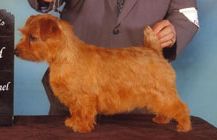Norfolk Terrier

|
From Wikipedia the free encyclopedia, by MultiMedia |
Norfolk Terrier |
||
|---|---|---|

A Norfolk Terrier at a
Dog show
|
||
| Alternative names | ||
| Country of origin | ||
| Great Britain | ||
| Common nicknames | ||
| Classification and breed standards | ||
| FCI: | Group 3 Section 2 #272 | |
| AKC: | Terriers | |
| ANKC: | Group 2 Terriers | |
| CKC: | Terriers | |
| KC (UK): | Terriers | |
| NZKC: | Terriers | |
| UKC: | Terriers | |
| Not recognized by any major kennel club | ||
| This breed of Dog is extinct | ||
| Notes | ||
The Norfolk Terrier is a small breed of Dog, one of many terrier breeds. Prior to 1960, when it gained recognition as an independent breed, it was a variety of the Norwich Terrier, distinguished from the Norwich by its "drop", or folded ears.
The Norfolk Terrier has a wire-haired coat which, according to the various national kennel club breed standards, can be "all shades of red, wheaten, black and tan, or grizzle."
They are the smallest of the working Terriers. They should feel heavier in weight than they appear to be. They are self confident and carry their heads with presence and importance and the tails should also be held erect.
They are active and compact, free moving, with good substance and bone. Good substance means good spring of rib and bone that matches the body such that the Dog can be a very agile ratter, the function for which it was bred. Norfolks are moderately proportioned Dogs. A too-heavy Dog would not be agile. A too-refined Dog would make it a toy breed. Norfolks generally have more reach and drive and a stronger rear angulation, hence cover more ground than their Norwich cousins. Norfolk have good side gait owed to their balanced angulation front and rear, not their perceived slightly longer length of back as is often cited.
The ideal height is 10 to 12 inches ( 25-30 cm) at the withers and weight is about 12 pounds (5 Kg). They are the smallest of the terriers.
These breeds have two coats - a harsh, wiry topcoat and a soft warm undercoat. All that is really necessary for grooming a companion Dog is a good combing and brushing once a week to remove the loose, dead hairs and prevent matting. The coats should be hand stripped once in the Fall and once in the Spring. Clipping or cutting ruins the coat's colours and texture. You can wash this coat with a Dog shampoo any time it is desirable.
Norfolk Terriers are described as fearless but should not be aggressive despite being capable of defending themselves if need be. The AKC standard describes the Norfolk as “alert, gregarious, and loyal”. They are Dogs that work in packs and must get along with other Dogs. They love people and children and can make good companions.
A Norfolk that is shy, or carries its tail between its legs is untypical as is a Dog that is hot tempered and aggressive with other Dogs; these are not the standard. Norfolk Terrier's typical breed temperament is happy, spirited and self confident.
There are incidences of health issues that responsible breeders consider worthy to do preventative testing. Norfolks have incidences of mitral valve disease, luxating patellas, hip dysplasia and bad bites (where the teeth do not align with the breed standard, ie. overshot or undershot)
A good daily walk takes care of the exercise requirements of the Norfolk Terrier. They are good walking companions and reasonable joggers.
In the 1880s, British sportsmen developed a working terrier of East Anglia, England. The Norwich Terrier and later the drop-eared variety now know as the Norfolk Terrier, were believed to have been developed by crossing Yorkshire Terriers, Cairn Terriers, and small, short-legged Irish Terrier breeds.
They were first called the Cantab Terrier when they became fashionable for students to keep in their dormitory at Cambridge University in England. Later, they were called the Thrumpington Terrier, after a street in the area where the breed was first developed. Then, just prior to WWI, a Norwich huntsman helped introduce the short-legged terriers to the USA, calling them the Jones Terrier.
In 1932, the Norwich was granted acceptance into the English Kennel Club and the first written standard was created. The American Kennel Club registered the first Norwich Terrier in 1936. In 1964, The Kennel Club reclassified the drop-ear variety as it its own breed, the Norfolk Terrier, and the prick-eared variety retained the name Norwich Terrier. The American Kennel Club and Canadian Kennel Club both recognized the division of the Norwich Terrier breed in 1979. After many generations, these two breeds have developed as two distinct breeds both in physical looks and in temperament. Of note, there is literature that suggests that the Norfolk and Norwich were always two distinct breeds and the original mistake was classifying them as one.
They are tireless workers in the field. These versatile, agreeable Dogs can go to ground and bolt a fox and tackle or dispatch other small vermin, working alone or in a pack. Their courage is so that “honourable scars from wear and tear” should not be counted against them in the show ring.